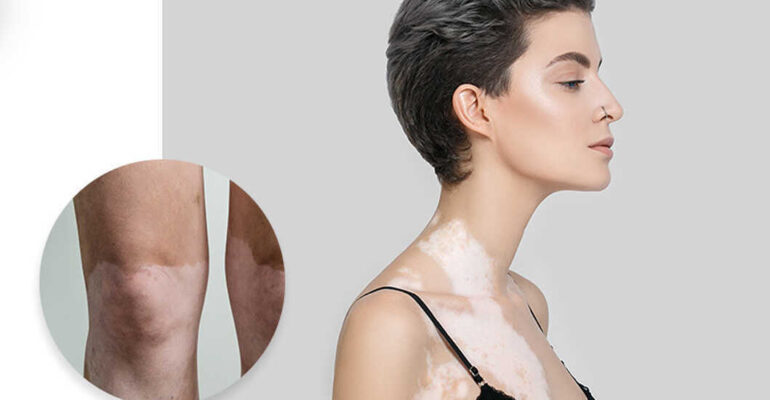Is That White Patch- Leukoderma or Vitiligo : FAQ On Vitiligo
August 24, 2021 2023-11-03 8:16Is That White Patch- Leukoderma or Vitiligo : FAQ On Vitiligo
As an Amazon associate, Dermatocare earns from valid purchase made by clicking on the affiliate links in this blog.

Is That White Patch- Leukoderma or Vitiligo : FAQ On Vitiligo
Doctor, I have a white patch on my skin. Is it Leukoderma, Vitiligo, or Something Else?”
Leukoderma refers to the loss of skin color, showing up as pale brown to white patches on your skin. Your skin’s color comes from melanin, a pigment produced by special cells called melanocytes. Leukoderma happens when there’s a loss or decrease in melanin or melanocyte function.
There are lots of reasons for leukoderma or hypopigmentation, and we’ll talk about the common ones:
- Nevus depigmentosus: A localized, painless white patch with regular or serrated borders in early childhood.
- Albinism: A congenital condition where you have little to no melanin in your skin, hair, and eyes.
- Pityriasis alba: White patches with unclear borders and fine scaling, often on the face.
- Vitiligo: A progressive disorder of hypopigmentation. We have discussed this in detail in the next section.
- Idiopathic guttate hypomelanosis: These are small white to light brown patches on shins and forearms that appear over the age of 40.
- Tinea versicolor: Caused by yeast, it leads to small white patches with fine scales, often on the upper back and chest.
- Post-inflammatory hypomelanosis: This happens due to damage to pigment-forming cells due to trauma or any skin disorders.
While all of these might look similar to you, the expert eye of a dermatologist can help you reach the diagnosis. Let us now dive deep into the most common cause of white patches on the skin, Vitiligo!
What is Vitiligo?
Vitiligo is a common depigmenting condition in which areas of skin lose pigment and appear white. It affects about 2 to 3 % of the world’s population. However, it is more prominent in people with dark skin.
It can occur at any age. However, the most common age of presentation is between 20 to 40 years of age.
What causes vitiligo?
Though the exact cause of Vitiligo is not known, it is considered to be an autoimmune condition; meaning that your immune system makes antibodies against your own pigment-forming cells (melanocytes) and results in their destruction.
What are Vitiligo symptoms?
Vitiligo appears as irregularly shaped patches of white skin, other than the color difference the skin appears normal. The most common sites of involvement are:
- Exposed areas- hands, face.
- Around body openings- eyes, nose, umbilicus, mouth & genitals.
- On trauma or damaged skin following a cut, scratch, etc.
- Segmental where it affects only a segment of the body.
What are the different types of vitiligo?
Based on distribution, vitiligo can be divided into various types:
Localized Vitiligo: Here the white patches are often concentrated on the part of the body.
Acrofacial- In this type, the white patches are restricted to the hands, feet, and face.
Dermatomal or Segmental: This entity is commonly seen in children when the white patches involve a segment of the body that typically does not cross the midline of the body.
Generalized Vitiligo: As the term generalized suggests, white patches appear in distant body parts.
Vitiligo Universalis- In this type, there is complete or nearly complete depigmentation with only a few areas of normal-coloured skin.
Can Vitiligo spread by touching?
No, Vitiligo is not contagious or infectious, meaning you cannot pass it to others by touching it.
Would my kids suffer from Vitiligo as well?
Only 20 to 30 % of people with vitiligo have a positive family history of the disease. Thus, there is a tendency to pass Vitiligo to the children, but that doesn’t mean that all children will definitely get it.
What will happen if I choose not to get myself treated?
The choice of getting yourself treated entirely depends on upon how you feel about your disease. It’s not a harmful disease- it does not cause any symptoms and does not have any internal involvement; the only reason to get it treated is cosmetic. If you decide to live with it, you just need to take special care of your skin because it’s more prone to sunburns and skin cancer.
What special care should be taken by patients of Vitiligo?
The white patches of Vitiligo are devoid of pigment melanin that helps protect your skin from damaging UV rays. Thus, white skin of vitiligo is more prone to developing sunburns and skin cancer. Thus, you protect your white skin by covering it with clothing. There are several other care techniques like acupuncture treatment and others that can help reduce the symptoms of this condition. Moreover, wide-brimmed hats can protect your face, neck & ears. Prefer to spend time in the shade between 11 am to 4 pm and use sunscreens on white patches regularly with SPF 30 or more. Sunscreens should be preferably applied 15 to 30 minutes before sun exposure and reapplied every 3 to 4 hours.
When to see a dermatologist?
If you are bothered by vitiligo, then consult a certified dermatologist for not only treatment but also counseling.
You will need regular follow-ups until your disease is controlled. You might need to revisit if there is the occurrence of new lesions or an increase in the size of existing ones. No single treatment can help all patients; instead, treatment needs to be individualized because each person is different and needs are different.
Be assured that treatment when started under the supervision of a dermatologist is efficient and free from side effects.
What are the various treatment options for Vitiligo?
Your dermatologist might prescribe one of the following treatment options:
Medical treatment consisting of oral & topical medicines, is briefly described below:
-
- Corticosteroid creams– These are the most common treatment given as vitiligo is considered to be of autoimmune origin, so steroids do have an active role. However, self-medication should not be done.
- Topical calcineurin inhibitors like Tacrolimus ointments are safer alternatives for steroids and are preferred to maintain the disease in remission.
- Bleaching (depigmentation treatments)- is used for Vitiligo Universalis, cases involving the almost whole of the body. It is a non-reversible permanent treatment, wherein remaining pigment cells are destroyed so as to completely depigment the skin. Commonly done by a medicine called as hydroquinone mono-benzyl ether.
- Oral therapy is used for stop the progression of diseases like Levamisole, Cyclophosphamide and Azathioprine
Phototherapy is of the following three types:
- PUVA treatments- in this psoralen are either given orally or topically and followed by exposure to sunlight or ultraviolet rays (UVA) after an hour.
- Narrowband UVB treatment is the most common type of light treatment, and it uses a light of a specific UVB wavelength.
- Lasers- 380-nm Excimer laser
Surgical treatments- The main aim of the surgical intervention is to produce cosmetically acceptable repigmentation of the affected skin. Works on the principle of melanocyte introduction in the vitiligo area which in turn will function as epidermal melanin units and work in the production of pigment thus offering a cure. It’s done only in stable cases i.e. no new lesions in the past one year. Various techniques are as follows
-
- Tissue grafts
- Mini punch grafting
- Suction blister grafting
- Thin split thickness grafting
- Hair follicle grafts
- Smash grafts
- Mesh grafts
Cellular Grafts
- Noncultured cell suspensions – epidermal cell and follicular cell
- Cultured melanocytes/keratinocytes grafts
No grafting techniques
- Micropigmentation
- Excision / Closure
- Dermabrasion
Skin Camouflage – It involves the use of special creams that help hide the vitiligo patches so that patients can live without feeling self-conscious. Camouflage doesn’t cure vitiligo it only makes them less visible. They are of the following types:
- Make-up: When correctly applied, skin camouflage is usually waterproof and also confers some sun protection. In this, the cream is applied and fixed with a powder after brushing the excess powder the color is fixed with fixing spray. The two popular brands of camouflage cream are Dermablend and Kryolan.
- Fake tans change the color of outermost layer of the skin and require less frequent applications then camouflage. For example, Vitocolor.
- Medical tattooing- More permanent method of camouflage but is suitable for small areas of skin like lips, and eyebrows.
Hormonal changes in the body as seen during adolescence.
- Damage to the skin from the cut, trauma, or sunburns.
- Extreme stress.
- Contact with certain chemicals.
Can Vitiligo spread by touching?
No, Vitiligo is not contagious or infectious, meaning you cannot pass it to others by touching it.
Would my kids suffer from Vitiligo as well?
Only 20 to 30 % of people with vitiligo have a positive family history of the disease. Thus, there is a tendency to pass Vitiligo to children, but that doesn’t mean that all children will definitely get it.
ROUTINE FINDER
Get free dermatologist-recommended regime by choosing your skin or concerns.

FACE

HAIRS

CHILD

BODY




